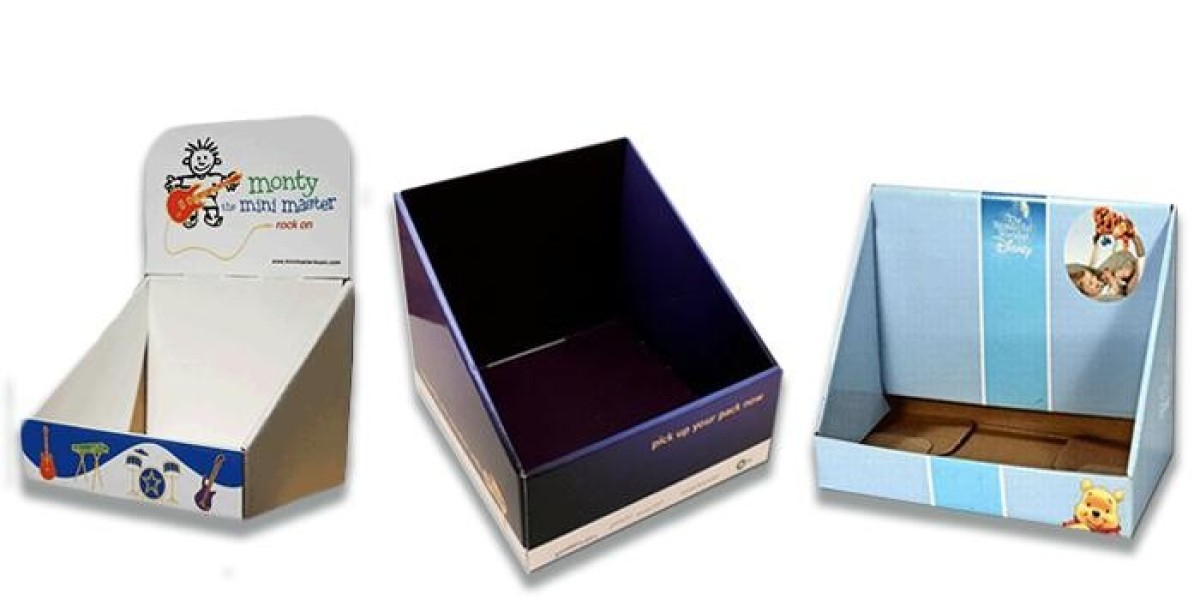They can serve as an essential tool to communicate brand identity and improve customer experience. The materials used in manufacturing these boxes directly impact their functionality, durability, and aesthetic appeal. This article will explore the different types of materials commonly used in display packaging boxes and how each contributes to their overall effectiveness.
The Importance of Choosing the Right Material for Display Packaging Boxes
The material used in display packaging boxes is crucial because it affects both the protection and presentation of the product. Display boxes are designed to be seen and interacted with, which means they must maintain the product’s integrity while showcasing it in the best light possible. Several factors must be considered when choosing a material for these boxes, including strength, cost-effectiveness, environmental impact, and the visual appeal of the packaging.
The material also dictates the flexibility of design options. Some materials allow for intricate designs and finishes, while others may limit creativity due to their rigidity. For example, corrugated cardboard is commonly used for display packaging due to its sturdiness and ability to withstand external pressures. On the other hand, materials like acrylic offer a sleek, modern look, ideal for high-end products. The choice of material also affects the production cost, with more premium materials leading to higher prices.
Sustainability has also become an increasingly important consideration. Many brands are moving toward eco-friendly materials to reduce their environmental footprint. By choosing biodegradable or recyclable materials, companies can appeal to a more eco-conscious consumer base while contributing to global sustainability efforts.
Cardboard: The Most Commonly Used Material
Cardboard is perhaps the most widely used material for display packaging boxes due to its versatility, durability, and cost-effectiveness. This material is commonly made from recycled paper pulp, which makes it a relatively sustainable option. Cardboard is known for its strength, which helps protect products from external damage during transport and storage.
In terms of display packaging, cardboard offers a wide range of customization options. It can be easily printed on, which makes it a perfect choice for businesses looking to promote their brand through visuals. Custom printing on cardboard boxes allows brands to create distinct designs that attract attention and convey their identity. The material can be cut into various shapes, sizes, and configurations, making it highly adaptable to different types of products.
Cardboard is also relatively light, which reduces shipping costs. Its smooth surface allows for high-quality printing and finishing, giving the boxes a professional and polished look. However, while cardboard is strong, it can be susceptible to moisture damage if not treated or coated appropriately. Many manufacturers use coatings to enhance the material’s resistance to water and wear, making it suitable for a variety of environmental conditions.
Corrugated Board: Strength and Durability
Corrugated board is another popular material used in display packaging boxes, especially for larger or heavier items. It consists of three layers: an outer liner, a fluted middle layer, and another inner liner. This structure provides exceptional strength and makes corrugated board ideal for protecting fragile or heavy products.
The corrugated design allows for better protection against physical impact and compression. This material is commonly used in retail settings where products need to be both visible and secure. The rigidity and thickness of corrugated board ensure that the display box can hold its shape, even when stacked with other boxes.
Corrugated boxes also offer excellent printing capabilities, similar to cardboard. They can be customized with vibrant colors and intricate designs to draw customers’ attention. Furthermore, corrugated board is highly recyclable, making it a popular choice among environmentally conscious brands. Many businesses opt for corrugated boxes because they offer a balance of durability, lightweight properties, and environmental friendliness.
Acrylic: Sleek and Premium Appearance
For products that require a high-end presentation, acrylic material is often chosen for display packaging boxes. Acrylic offers a sleek, transparent finish that allows customers to see the product without opening the packaging. This material is ideal for luxury or premium products such as electronics, jewelry, or cosmetics.
Acrylic is known for its clarity, making it a great choice for products that need to be showcased in the most visually appealing way possible. Unlike cardboard or corrugated material, acrylic is highly resistant to moisture, making it suitable for long-term storage. Additionally, acrylic can be molded into different shapes and sizes with precision, allowing for creative and customized display solutions.
The durability of acrylic ensures that it can withstand both handling and environmental conditions without becoming damaged. However, acrylic can be more expensive than other materials, which might limit its use to higher-end products or brands with a larger marketing budget. Despite the cost, the professional look and durability often justify the price for products where presentation is a key factor.
Paperboard: Lightweight and Flexible
Paperboard is a lightweight yet durable material used in the production of display packaging boxes. It is thinner and more flexible than cardboard and is often used for smaller products or those that require less protection. Paperboard is commonly used in food packaging, cosmetics, and other retail products that need an attractive display without the need for heavy-duty protection.
Despite its lightweight nature, paperboard can be quite sturdy when properly constructed. It offers the same customization options as cardboard and is often used for point-of-purchase displays, where the focus is on visual appeal rather than heavy-duty protection. Its smooth surface is ideal for high-quality prints, making it perfect for brands that want to make a statement with their packaging.
One of the primary advantages of paperboard is its cost-effectiveness. It is less expensive to produce than materials like acrylic or corrugated board, making it a popular choice for brands that want to balance cost and aesthetics. However, it may not be suitable for products that require extra protection during transport or handling, as paperboard is more susceptible to bending and tearing compared to other materials.
Plastic: Durability and Transparency
Plastic is commonly used in the manufacturing of display packaging boxes, especially for products that require durability and visibility. The most common types of plastic used are PET (Polyethylene Terephthalate) and PVC (Polyvinyl Chloride), both of which offer excellent clarity and can be molded into a variety of shapes.
One of the major benefits of plastic is its transparency, which allows consumers to see the product clearly. This is particularly useful for items such as electronics, toys, and accessories, where visibility is crucial for customer decision-making. The durability of plastic makes it a good choice for packaging that needs to protect fragile items from impact or environmental factors.
Plastic is also highly versatile. It can be manufactured in a wide range of colors, and its smooth surface allows for high-quality printing. However, plastic packaging tends to be less environmentally friendly than other options due to its limited recyclability. As a result, many companies are exploring ways to make their plastic packaging more sustainable by using biodegradable plastics or recyclable materials.
Eco-Friendly Materials: Sustainable Options for Packaging
Sustainability is an increasingly important consideration in the packaging industry, and many brands are moving toward using eco-friendly materials for their display packaging boxes. Materials such as recycled paper, biodegradable plastics, and even plant-based fibers are becoming popular alternatives to traditional packaging materials.
Recycled paper and cardboard are two of the most widely used eco-friendly materials. They are made from post-consumer waste and can be easily recycled again, reducing the need for new raw materials. Biodegradable plastics, such as those made from cornstarch or sugarcane, offer a sustainable alternative to traditional plastic and break down naturally over time.
Another innovative solution is the use of plant-based fibers, such as bamboo or hemp, in packaging. These materials are renewable and require fewer resources to produce compared to traditional materials. Many companies are now choosing these eco-friendly materials to meet consumer demand for sustainable products and reduce their environmental impact.
By opting for sustainable packaging materials, brands can not only reduce their carbon footprint but also appeal to eco-conscious consumers. This shift toward more environmentally friendly materials is an essential step in the overall effort to create a more sustainable and responsible packaging industry.
The Future of Display Packaging Boxes
As consumer preferences continue to evolve, the future of display packaging boxes will likely be shaped by advancements in materials technology and sustainability. Companies will increasingly adopt materials that are both innovative and eco-friendly, ensuring that their packaging is not only functional but also environmentally responsible.
In the coming years, we can expect to see more integration of smart technologies in display packaging, such as QR codes or NFC (Near Field Communication) chips, which allow for more interactive and personalized consumer experiences. Additionally, packaging solutions will become even more customizable, with the use of advanced printing techniques and new materials that offer better performance.
As the demand for sustainable packaging grows, manufacturers will continue to explore new and innovative ways to reduce waste and improve the recyclability of display packaging boxes. The future will likely see a shift toward materials that are not only functional but also capable of contributing to a circular economy, where products and materials are reused, recycled, or biodegraded after use.
Conclusion
In conclusion, understanding the materials used in display packaging boxes is essential for brands looking to create effective and attractive packaging solutions. The material chosen directly affects the box's strength, aesthetic appeal, and environmental impact. Whether opting for cardboard, corrugated board, acrylic, or eco-friendly alternatives, each material offers unique benefits and challenges. By carefully considering the requirements of the product and the brand’s goals, businesses can choose the right materials to enhance their packaging while meeting consumer expectations for quality, sustainability, and visual appeal.
Visit Our Website: https://ibexpackaging.com/display-boxes/








